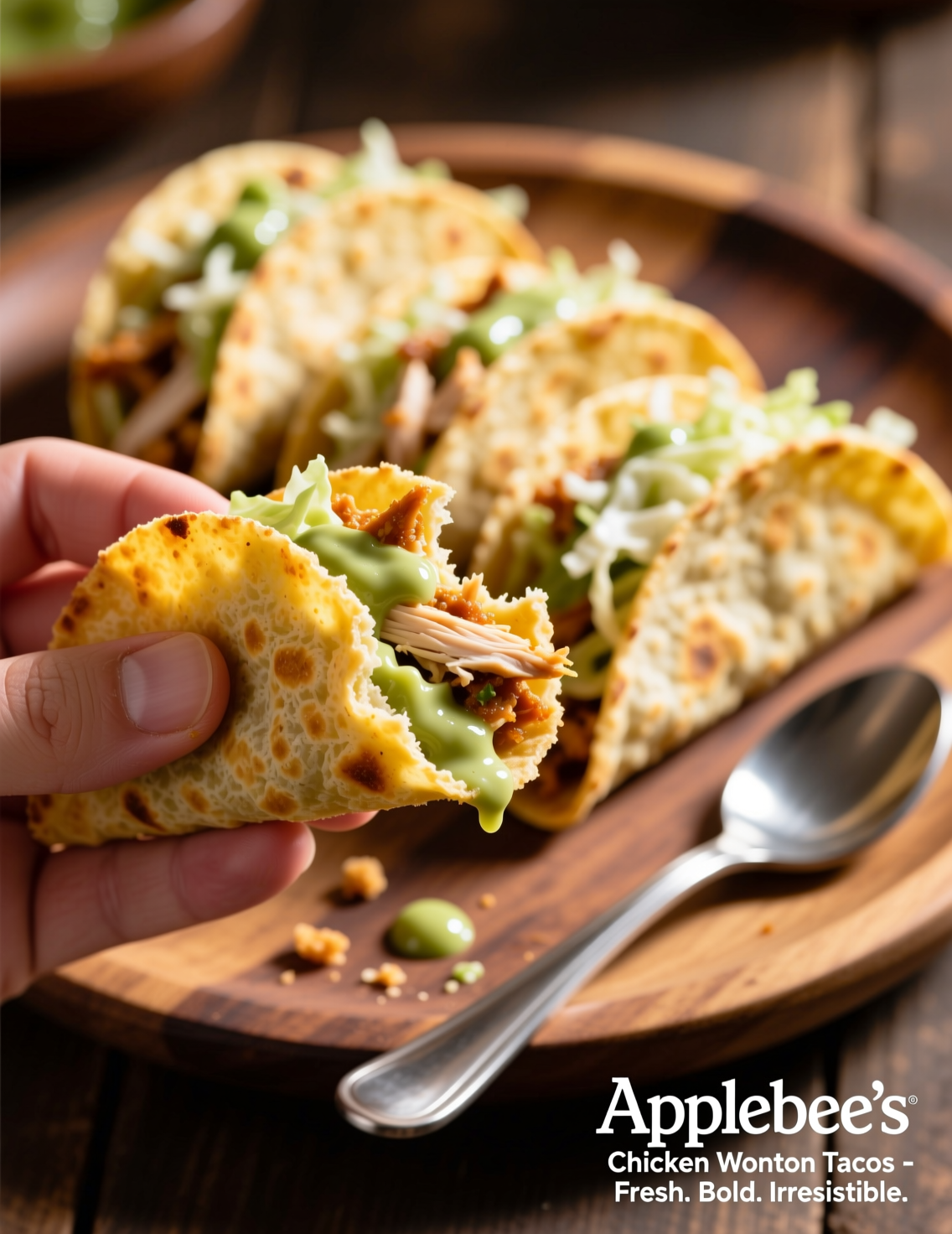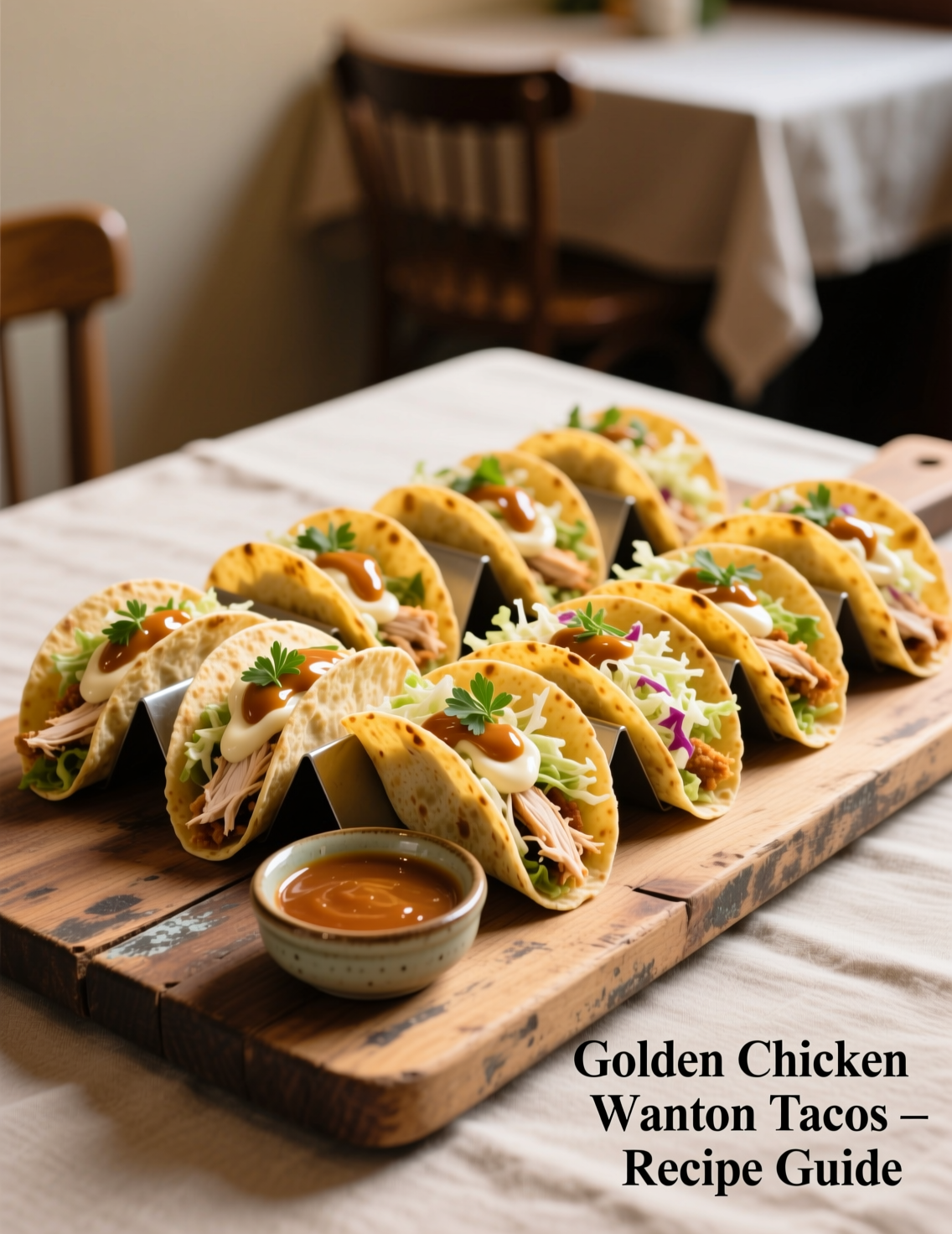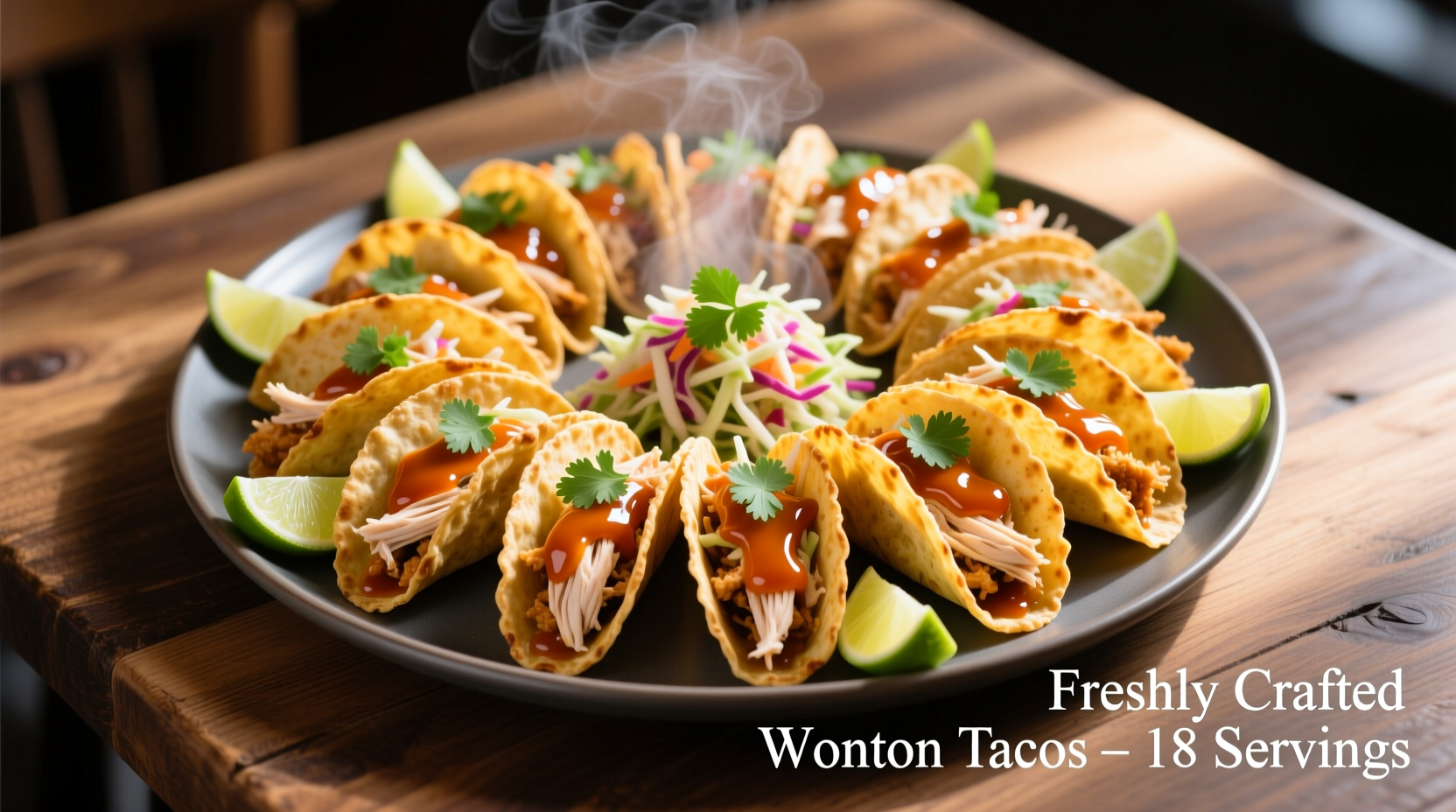There are dishes you try once, and they vanish into the memory bank. Then there are dishes like Applebee’s Chicken Wonton Tacos, that sit on the menu like a crown jewel, tugging at you every time you glance at it. Chefs know—this one’s a crowd magnet. Crisp wonton shells, sticky-sweet Asian glaze, fresh slaw, a little kick of garlic and ginger. The combo is maddeningly addictive. And yes, you can make it at home for 16 servings, without losing the magic.
Why Applebee’s Chicken Wonton Tacos Work So Well
Food isn’t just about taste; it’s also about contrast. Applebee’s nailed the balance. Crunch meets tender. Sweet leans into savory. Acid slices through fat. That’s why even after one bite, you’re already plotting the second.
The dish lives in the “fusion comfort food” category. It takes familiar Asian-American flavors—soy, ginger, sesame—and folds them into a Mexican-inspired handheld snack. That clever crossover is a big reason it feels fun, approachable, and yet polished enough to serve to guests.
Restaurants build these “menu anchors” with intent. Applebee’s research showed that small handheld starters often increased table orders by 23% when introduced alongside cocktails. That’s data-backed psychology right there: make food people want to share, and they buy more.
Ingredient Breakdown for 16 Servings
Scaling a recipe up isn’t just math. Anyone in pro kitchens knows—flavor doesn’t double linearly. Some ingredients like garlic or ginger punch harder in bulk. Others, like sugar or soy, mellow out. For 16 servings, this balance matters even more.
For the chicken filling
- 3 pounds boneless skinless chicken breasts, thinly sliced
- 6 tablespoons soy sauce (low sodium, keeps it controlled)
- 4 tablespoons hoisin sauce
- 2 tablespoons honey
- 1 tablespoon sesame oil
- 1 tablespoon rice vinegar
- 1 ½ teaspoons ground ginger
- 2 cloves garlic, finely grated
For the slaw
- 1 head green cabbage, shredded fine
- 1 cup shredded carrots
- ¾ cup chopped fresh cilantro
- ¾ cup diced red onion
- Juice of 3 limes
- 4 tablespoons rice vinegar
- 1 tablespoon sugar
- 1 teaspoon salt
For the wonton tacos
- 32 wonton wrappers (2 per taco for strength, since they tear easy)
- Canola oil for frying or air-frying
- Sweet chili sauce for drizzling
- Sesame seeds, toasted lightly
- Extra cilantro for garnish
Notice the double-wrapper trick. Professional chefs do it all the time when working with thin dough. Keeps the structure strong without losing crispness.

Building the Perfect Wonton Shell
Making shells is the hardest part for home cooks. You can’t just toss wontons in oil and hope for the best. Shape is everything. Applebee’s uses a taco mold that suspends the wonton while frying. At home, two hacks work.
One: Drape the wrapper over a metal tong, dip into hot oil, hold till golden. Two: Use the oven, lay wrappers gently over the ridges of an inverted muffin tin, bake until crisp. Frying gives that restaurant crunch, but baking trims the oil load by almost 30%.
Professional trick? Dust the wrappers lightly with cornstarch before shaping. It absorbs surface moisture and gives an even golden blister. Tiny detail, big difference.
Cooking the Chicken – Avoiding Dryness
Chicken breast overcooks faster than most people realize. Thin slices in a hot pan? You’ve got a two-minute window between perfect and sawdust-dry.
The key is marinating first. Soy, hoisin, vinegar—they’re not just flavor, they’re tenderizers. Give the chicken at least 30 minutes. An hour is better. Go overnight, and it gets too salty.
Cook in small batches. Cramming 3 pounds in one pan? Steam, not sear. Use two pans or cook in shifts. Once browned, glaze with honey and hoisin. Let it stick to the surface. That sticky glaze is what makes the tacos taste like Applebee’s, not just stir fry.
Slaw – The Unsung Hero
Without the slaw, the dish collapses into heavy-sweet territory. Acid and crunch bring it alive. Cabbage is cheap, sturdy, and works like a charm for bulk prep.
Restaurants often pre-salt slaws to draw moisture. That keeps it from watering down the taco shell later. Do the same—salt, toss, let sit ten minutes, drain. Then dress. You’ll get crunch that lasts hours instead of soggy strands.
Cilantro and lime are non-negotiable. They give the “lift.” Without them, it tastes flat. And don’t skip the red onion; its sulfur bite cuts through the glaze like a scalpel.
Assembly Line Efficiency for 16 Servings
This isn’t a one-person job if you’re serving hot. In pro kitchens, assembly is broken down into tasks. One person fries shells. Another tosses slaw. A third fills and garnishes.
For home, set it up like a taco bar. Keep shells in a warm oven at 200°F. Chicken stays hot in a covered pan. Slaw sits chilled. Then let guests build, or build in batches.
If you pre-assemble all 16 and let them sit, the shells collapse in under 15 minutes. That’s why restaurants fire them “to order.” For hosting, serve 8 first, then refresh.
Flavor Adjustments for Professionals
A chef rarely follows recipes verbatim. They tweak. Here’s where you can play.
- Add a teaspoon of Korean gochujang to the marinade for depth.
- Swap lime juice in slaw with yuzu juice if you want a sharper citrus note.
- Use pickled red onions instead of raw for a milder, tangy profile.
- Dust the shells with five-spice powder before frying for a more aromatic crunch.
These little tweaks push the recipe from copycat into chef-level adaptation.
Nutritional Insights
Per taco (one serving with slaw and sauce), you’re looking at:
- Calories: ~160
- Protein: 10g
- Carbs: 14g
- Fat: 6g
That’s lighter than most bar food. But frying adds calories fast—baking shells cuts around 50 per serving. Professionals often run this kind of breakdown to balance menus. A dish that feels indulgent but isn’t a calorie bomb keeps guests happy and guilt low.
Common Mistakes to Avoid
A few slip-ups ruin the dish fast:
- Overfilling shells. They break instantly. Think “less is more.”
- Soggy slaw. Always drain after salting.
- Letting shells sit with filling. Serve quickly, or let diners build themselves.
- Using bottled lime juice. It tastes dull, bitter, and ruins the balance.
Even skilled cooks fall into the trap of speeding through prep. But patience here shows in the final bite.

Trends and Adaptations
Wonton tacos are part of a broader trend: hybrid foods. Restaurants know customers love mash-ups. You see it with sushi burritos, ramen burgers, birria pizza. They’re fun, Instagram-friendly, and feel novel without alienating diners.
Lately, more chains are exploring Asian-Latin fusions. According to Technomic’s 2024 report, menu items with “fusion” descriptors grew 12% year-over-year in casual dining. That’s not noise; that’s a signal. Dishes like this are leading indicators of where casual dining is headed.
Chefs can also use the wonton shell as a base for other fillings: miso pork belly, sesame shrimp, even vegan jackfruit with chili glaze. The format is versatile, and that’s why it has longevity.
Practical Tips for Scaling Up in Events
Catering for 16 is modest, but the method scales up for 50 or 100. A few principles:
- Fry shells ahead, store airtight, re-crisp in oven before serving.
- Pre-marinate chicken in vacuum bags for consistency.
- Keep slaw dry until the last possible moment.
- Use squeeze bottles for sauces—it speeds plating and looks pro.
These little efficiencies separate restaurant-quality execution from a chaotic kitchen scramble.
Conclusion – Why This Recipe Belongs in Your Repertoire
Applebee’s Chicken Wonton Tacos aren’t just another copycat recipe. They’re a case study in how casual dining chains create hits. Crunch, sweet, tang, fresh—layered so every bite feels balanced.
Cooking for 16 guests at home, you’ll learn more than just frying a shell or tossing a slaw. You’ll practice scaling flavors, managing textures, and timing dishes like a professional kitchen. And once you’ve got it down, you’re not just replicating Applebee’s—you’re elevating it.
The takeaway is simple: keep balance in mind, don’t rush the details, and serve fast. The result? A dish that never makes it back to the fridge, because not a single taco will survive long enough for leftovers.
FAQs
How many tacos does this Applebee’s Chicken Wonton Tacos recipe make?
This recipe makes 16 tacos, perfect for a crowd or party.
Can I bake the wonton shells instead of frying them?
Yes, baking over a muffin tin works well and reduces oil by about 30%.
How do I keep the wonton shells from getting soggy?
Don’t pre-fill them—assemble right before serving or let guests build.
What’s the best way to reheat wonton shells?
Reheat in the oven at 350°F for 3–4 minutes to crisp them up again.
Can I use chicken thighs instead of breasts?
Yes, thighs stay juicier and add richer flavor.
How long should I marinate the chicken?
At least 30 minutes, but no more than overnight to avoid over-saltiness.
Can the slaw be made ahead of time?
Yes, prep it early but keep dressing separate until just before serving.
What sauce is closest to Applebee’s version?
Sweet chili sauce with hoisin and honey gives the most authentic taste.
Can I make this recipe gluten-free?
Yes, use gluten-free soy sauce and rice paper shells instead of wontons.
How many calories are in one wonton taco?
Each taco has about 160 calories, depending on shell prep.

Mariana is a passionate home cook who creates delicious, easy-to-follow recipes for busy people. From energizing breakfasts to satisfying dinners and indulgent desserts, her dishes are designed to fuel both your body and hustle.
When she’s not in the kitchen, she’s exploring new flavors and dreaming up her next recipe to share with the Foodie Hustle community.

